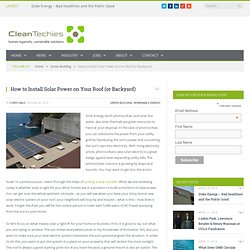

How to Install Solar Power on Your Roof (or Backyard) Solar Energy (both photovoltaic and solar hot water, aka solar thermal) are great resources to have at your disposal.

In the case of photovoltaic, you can substitute the power from your utility grid by harnessing the sun’s power and converting the sun’s rays into electricity. With rising electricity prices, photovoltaics (aka solar electric) is a great hedge against ever expanding utility bills. The photovoltaic industry is growing by leaps and bounds. You may want to get into the action. How? So let’s focus on what makes solar a right fit for your home or business. 1) Orientation to the sun – South facing As we know the sun rises in the east and sets in the west. Most buildings do not have a roof that faces exactly true south so if you have a pitched (or angle roof), then you would choose the roof areas that face south. 2) Tilt – Angle of the panels Now that you have found which roof area(s) are south facing , the next factor is tilt. 3) Shading – Obstacles blocking the sun.
Electricity. Hydrogen. Solar. Solar improving design/tech. Solar Power More Competitive Than Decision-Makers Or Consumers Realize. 'Solar panel' eye implant promises sight without wires - tech - 13 May 2012. Tiny "solar panels" implanted into the eye could one day restore vision to the blind without the need for any ugly wires.

Around 15 million people worldwide have some form of blindness. In people with these conditions the retina's photoreceptors, which transform light hitting the eye into electrical impulses, are often damaged, preventing visual information from being sent to the brain. Several companies, such as Second Sight in Sylmar, California, have developed prosthetic retinas, some of which are currently in clinical trials. Such technologies generally use a camera to detect visual information that is then relayed through a wire to an implant inside the eye.
The implant effectively replaces the damaged photoreceptors. Wireless vision So along with Daniel Palanker and colleagues, Loudin set out to build a tiny wireless implant out of photovoltaic pixels – similar to those found in rooftop solar panels. Second sight Journal reference: Nature Photonics, DOI: 10.1038/nphoton.2012.104. Le solaire - Énergies nouvelles et renouvelables. L'énergie solaire thermique est essentiellement utilisée pour le chauffage de l'eau chaude sanitaire et peut aussi être utilisée pour le chauffage des bâtiments.

L'énergie thermique est aussi rentable pour un habitat individuel qu'un bâtiment collectif (hôpital, immeuble, etc.)Le crédit d'impôt instauré en 2005 a permis un véritable décollage de la filière. Aujourd'hui ces équipements bénéficient d'un crédit d'impôt de 50%. Dans certains pays (Allemagne, Autriche, Espagne, Grèce, Turquie, Japon, Australie), l'énergie solaire thermique ou le chauffe-eau solaire sont très souvent intégrés comme une ligne budgétaire classique dans les projets de constructions individuelles. Photovoltaïque - quel est l'impact environnemental de l'énergie solaire photovoltaïque ? Les effets de l'énergie solaire photovoltaïque sur les principaux facteurs environnementaux sont les suivants : Climat : la génération d'énergie solaire électrique directement à partir de la lumière solaire ne requiert aucun type de combustion, et donc aucune émissions de gaz a effet de serre.Géologie : Les cellules photovoltaïques sont fabriquées avec du silicium, élément obtenu du sable, très abondant dans la nature et dont on ne requiert pas de quantités significatives.

Par conséquent, les modifications topographiques ou structurelles de terrain et les impacts sur l’environnement engendrés par la fabrication de panneaux solaires photovoltaïques sont nulles.Sol : Ne produisant ni polluants, ni déchets, ni mouvements de terre, l'incidence sur les caractéristiques physico-chimiques du sol ou son facteur d’érosion est nulle.
Eaux superficielles et souterraines : Aucune modification des nappes phréatiques ou des eaux superficielles. En savoir plus sur les énergies renouvelables. Energie solaire : Fonctionnement de l'énergie solaire, informations sur l'électricité solaire avec POWEO, spécialiste de l'énergie solaire.